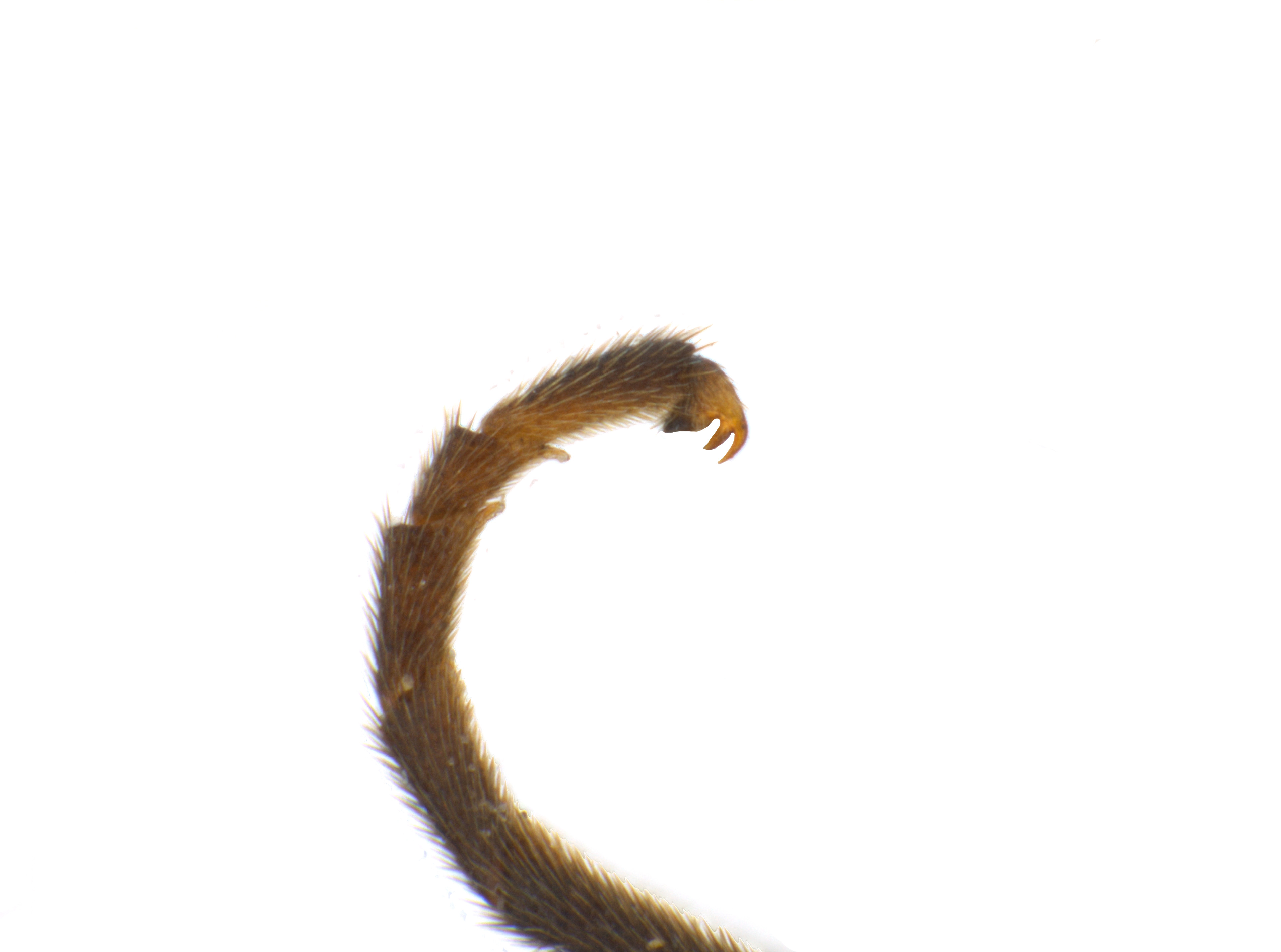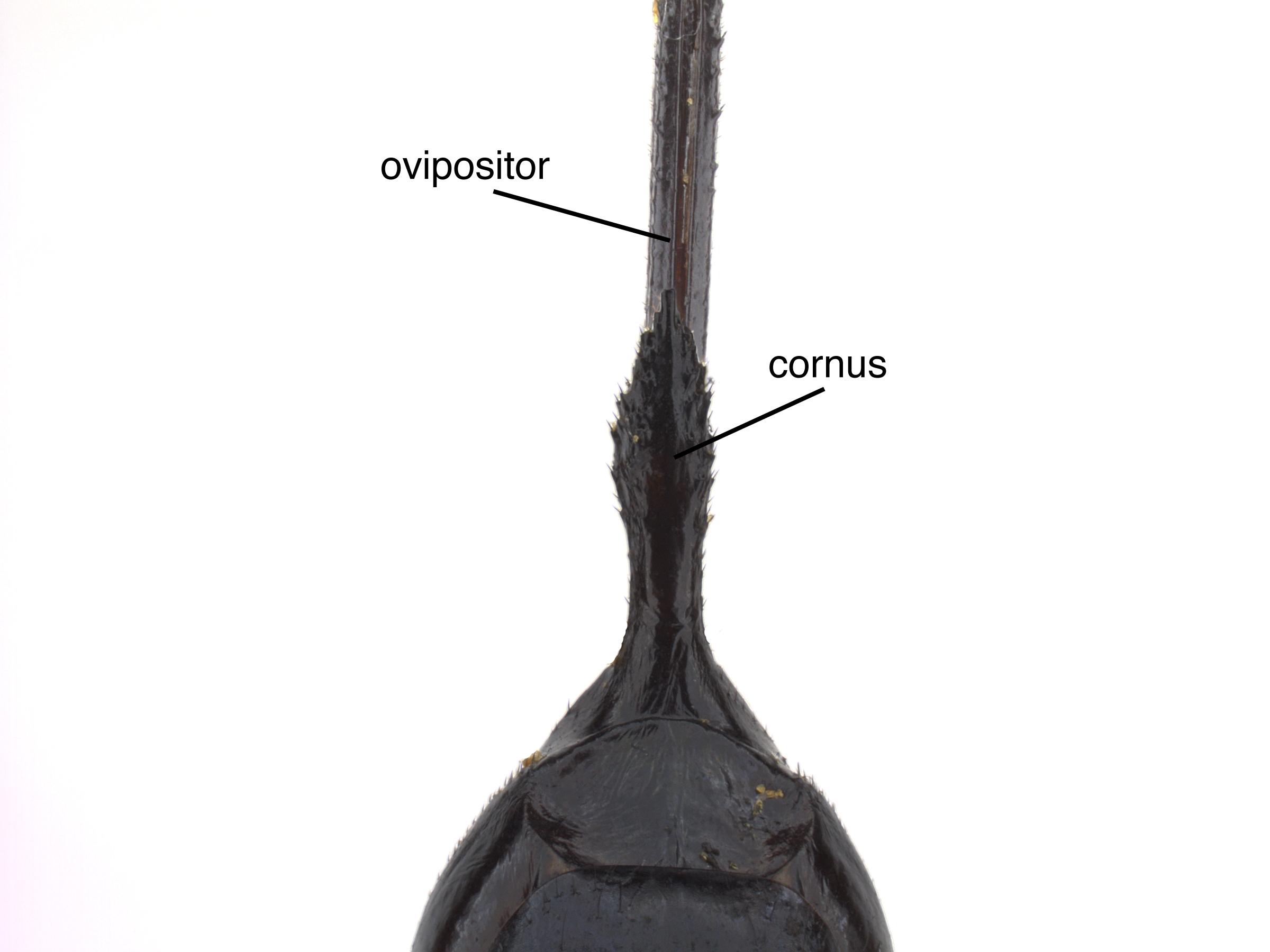Family: Tenthredinidae
Family common name: common sawflies
Subfamily: Allantinae
Tribe: Allantini
Genus: Macremphytus MacGillivray, 1908
Subgenera: none
The Tenthredinidae are the most species-rich family and are found throughout the world, in all continents but Antarctica. They are known as the “common sawflies.” They can generally be recognized by a cylindrical body and long, segmented antennaeantenna:
the sensory organ emerging from the front of the head, usually between the compound eyes and above the clypeus; includes the flagellum, scape and pedicel
 . Otherwise, they come in a variety of colors, sizes, and forms (Goulet 1992Goulet 1992:
. Otherwise, they come in a variety of colors, sizes, and forms (Goulet 1992Goulet 1992:
Goulet H. 1992. The genera and subgenera of the sawflies of Canada and Alaska: Hymenoptera. Symphyta. The insects and arachnids of Canada. Part 20. Agriculture Canada Publication.).
Sawflies in the Allantinae subfamily are mostly black and shining, sometimes with other colors. They have agricultural importance as some species are pests on cultivated and ornamental plants (Smith 1979aSmith 1979a:
Smith DR. 1979a. Nearctic sawflies. IV. Allantinae: Adults and larvae (Hymenoptera: Tenthredinidae). Technical Bulletin, U.S. Department of Agriculture 1595: 1-172.). They can be distinguished from other subfamilies by wing venationvenation:
the network of veins on a wing
(Smith 2003aSmith 2003a:
Smith DR. 2003a. A Synopsis of the sawflies (Hymenoptera: Symphyta) of America south of the United States: Tenthredinidae (Allantinae). Journal of Hymenoptera Research 12 (1): 148-192.).
Macremphytus are medium-sized, about 8–12 mm in length, and generally black and reddish-brown. The genus is associated with dogwood trees (Smith 1979aSmith 1979a:
Smith DR. 1979a. Nearctic sawflies. IV. Allantinae: Adults and larvae (Hymenoptera: Tenthredinidae). Technical Bulletin, U.S. Department of Agriculture 1595: 1-172.).
There are six described extantextant:
in existence; opposite of extinct
species worldwide. Five occur in North America (Taeger et al. 2010Taeger et al. 2010:
Taeger A, Blank SM, and Liston AD. 2010. World Catalog of Symphyta (Hymenoptera). Zootaxa 2580: 1-1064.).
A NearcticNearctic:
describing the region of the Northern Hemisphere that includes North America south through northern Mexico
 key to species is included in Smith 1979aSmith 1979a:
key to species is included in Smith 1979aSmith 1979a:
Smith DR. 1979a. Nearctic sawflies. IV. Allantinae: Adults and larvae (Hymenoptera: Tenthredinidae). Technical Bulletin, U.S. Department of Agriculture 1595: 1-172..
Subfamily characters
 vein M and 1m-cu parallel (Smith 1979aSmith 1979a:
vein M and 1m-cu parallel (Smith 1979aSmith 1979a: vein 2A+3A complete, connected to 1A by crossveincrossvein:
vein 2A+3A complete, connected to 1A by crossveincrossvein:Genus characters
 , right simple (Smith 1979aSmith 1979a:
, right simple (Smith 1979aSmith 1979a: deeply notched and circularly emarginated (Smith 1979aSmith 1979a:
deeply notched and circularly emarginated (Smith 1979aSmith 1979a: vein 2r present (Smith 1979aSmith 1979a:
vein 2r present (Smith 1979aSmith 1979a: vein M intersecting Sc+R at the intersection of Sc+R and Rs+M (Smith 1979aSmith 1979a:
vein M intersecting Sc+R at the intersection of Sc+R and Rs+M (Smith 1979aSmith 1979a: cellcell:
cellcell: M present (Smith 2003aSmith 2003a:
M present (Smith 2003aSmith 2003a: with basalbasal:
with basalbasal:Macremphytus can be confused with similar species in the subfamily Allantinae or tribe Allantini. It can be distinguished from most other genera by the asymmetrical mandibles, deep circular clypeusclypeus:
sclerotized area on the front of the head located between the antennal insertions and labrum
 emargination, flattened antennal segments, and the presence of cellcell:
emargination, flattened antennal segments, and the presence of cellcell:
1. a membranous area of the wing between veins, 2. a small cavity or closed space
 M in the hind winghind wing:
M in the hind winghind wing:
the posterior wing of each pair of wings
 (Smith 1979aSmith 1979a:
(Smith 1979aSmith 1979a:
Smith DR. 1979a. Nearctic sawflies. IV. Allantinae: Adults and larvae (Hymenoptera: Tenthredinidae). Technical Bulletin, U.S. Department of Agriculture 1595: 1-172.).
none
In North America, Macremphytus feeds on Cornuscornus:
a pointed horn-like process on the apical end of the abdomen in Siricidae sawflies; on tergite 10 in females, sternite 9 in males
 (dogwood) trees, including C. alternifolia (pagoda dogwood), C. racemosa (gray dogwood), Cornus cornus:
(dogwood) trees, including C. alternifolia (pagoda dogwood), C. racemosa (gray dogwood), Cornus cornus:
a pointed horn-like process on the apical end of the abdomen in Siricidae sawflies; on tergite 10 in females, sternite 9 in males
 alba (tatarian dogwood), and C. sericea (redosier dogwood) (Smith 1979aSmith 1979a:
alba (tatarian dogwood), and C. sericea (redosier dogwood) (Smith 1979aSmith 1979a:
Smith DR. 1979a. Nearctic sawflies. IV. Allantinae: Adults and larvae (Hymenoptera: Tenthredinidae). Technical Bulletin, U.S. Department of Agriculture 1595: 1-172., Klingeman et al. 2007Klingeman et al. 2007:
Klingeman WE, Chen F, Kim HJ, and Flanagan PC. 2007. Feeding preferences of dogwood sawfly larvae indicate resistance in Cornus . Journal of Environmental Horticulture 25 (3): 134-138., O’Brien 2015).
Female Macremphytus lay eggs near the mid veinvein:
a tube-like, often darkened, structure on the wings
 of the leaf. LarvaeLarva:
of the leaf. LarvaeLarva:
the immature stage of holometabolous insects
 feed externally on foliage and then overwinter as prepupae in decayed wood or wooden structures. All known species are univoltineunivoltine:
feed externally on foliage and then overwinter as prepupae in decayed wood or wooden structures. All known species are univoltineunivoltine:
describing an insect with a life cycle of one generation per year
(Smith 1979aSmith 1979a:
Smith DR. 1979a. Nearctic sawflies. IV. Allantinae: Adults and larvae (Hymenoptera: Tenthredinidae). Technical Bulletin, U.S. Department of Agriculture 1595: 1-172.).
Macremphytus tarsatus is a pest of dogwood that has been observed feeding gregariously, resulting in skeletonizing and complete defoliation of trees. Because dogwood is deciduousdeciduous:
describing a tree that drops its foliage once a year and then re-grows it; often senescence occurs before winter and re-growth occurs in the spring
, and because defoliation occurs most often late in the season, an infestation of M. tarsatus is usually not fatal to the tree. Macremphytus tarsatus is univoltineunivoltine:
describing an insect with a life cycle of one generation per year
(O’Brien 2015).
World: This genus is mostly known from North America, with one species, M. crassicornis, in East and Southeast Asia (Smith 1979aSmith 1979a:
Smith DR. 1979a. Nearctic sawflies. IV. Allantinae: Adults and larvae (Hymenoptera: Tenthredinidae). Technical Bulletin, U.S. Department of Agriculture 1595: 1-172., Taeger et al. 2010Taeger et al. 2010:
Taeger A, Blank SM, and Liston AD. 2010. World Catalog of Symphyta (Hymenoptera). Zootaxa 2580: 1-1064.).
North America: Macremphytus occurs in northern United States and southern Canada. Macremphytus lovetti is restricted to west of the Rocky Mountains, in Alberta, British Columbia, Oregon, Idaho, and Montana, while the other species are widespread east of the Rocky Mountains as far south as northern Georgia (Smith 1979aSmith 1979a:
Smith DR. 1979a. Nearctic sawflies. IV. Allantinae: Adults and larvae (Hymenoptera: Tenthredinidae). Technical Bulletin, U.S. Department of Agriculture 1595: 1-172.). Macremphytus albitegularis is more southern in distribution and has been collected once from Dallas, Texas and once from Mexico, specific locality unknown (Koch 1988bKoch 1988b:
Koch F. 1988b. Eine neue art der gattung Macremphytus MacGillivray, 1908 (Hymenoptera, Tenthredinidae). Deutsche Entomologische Zeitschrift, Neue Folge 35 (1-3): 199-201., Smith 2003aSmith 2003a:
Smith DR. 2003a. A Synopsis of the sawflies (Hymenoptera: Symphyta) of America south of the United States: Tenthredinidae (Allantinae). Journal of Hymenoptera Research 12 (1): 148-192.).
Map data from: GBIF.org (29 October 2019) GBIF Occurrence Download Macremphytus
Details about data used for maps can be found here.